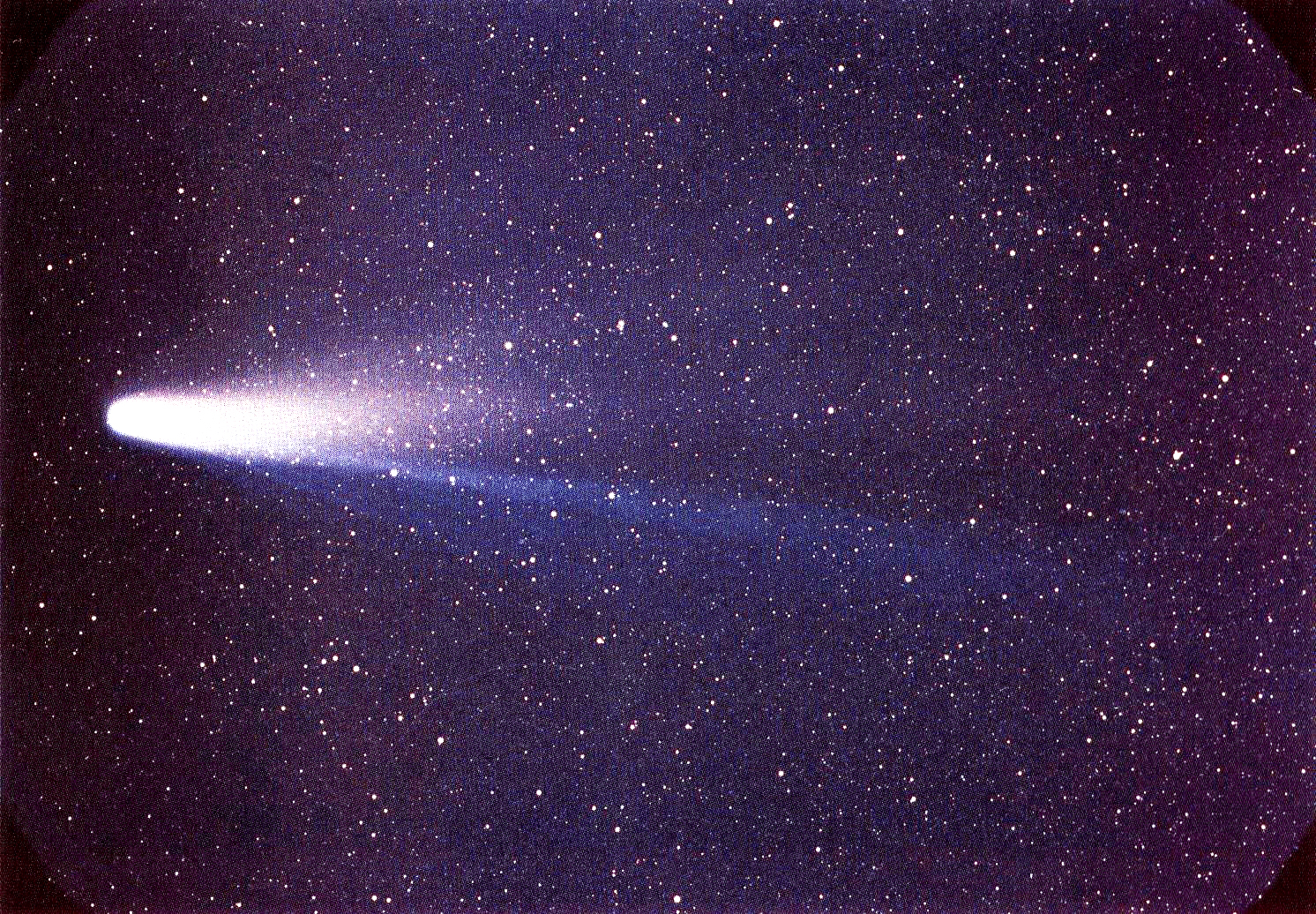Part 1 - Mother Nature gave us a nice Christmas present in the winter of 1985-1986 - Halley's comet came to visit. Halley is a fairly predictable visitor to the neighborhood of the Sun - it's a periodic ice ball that shows up every 75 years or so. It's arrivals have been recorded since 240 BC - before that, there is no written record of it's close encounters with Earth. As the comet gets close to the Sun, the solar wind and heat ablate the surface of the comet creating a long tail of gas and ice crystals. The tail reflects sunlight and can be quite bright.
 |
| Comet P/Halley as taken March 8, 1986 by W. Liller |
As Halley approached Earth, some Earthlings, including me, became very excited. Some people predicted the end of the world. With a diameter of 10 km, a collision with Halley would cause a major extinction with an energy of 2 million hydrogen bombs. The chances of collision were zero - whew !!
My fever grew and grew until I had to go to Arizona to see it at it's clearest. I flew to Phoenix and rented a car. From there, I drove to Tucson and visited the university astronomy department. Realizing my interested, one astronomer invited me to spend a night with him at the huge mountain telescope on Kitt Peak, at 2,100 meters, in the mountains of the Sonora Desert. I drove up the mountain a few hours before sunset - and watched the telescopes open up for the night's activities. The main telescope is housed in a large white building, 57 meters high, with a hemispherical dome. It was cold - winter at elevation in a dry desert - around -6 C. The sky felt cold as well.
Dusk settled into night - the exterior lights were turned off. Lights were dimmed inside the buldings as well. My eyes adapted to the pure darkness. A few shooting stars streaked by leaving orange trails. The mountain became very dark and quiet. The sky was so clear, I felt I could reach out and touch it. In this setting, the Milky Way, our galaxy, is a blazing stripe of brightness that dominates the sky. Above and below the stripe are thousands of bright and dim stars - these are Earth's neighbors since we are surrounded by local stars. There are a some dimmer objects which are not local stars - they are nearby galaxies which look like stars with the naked eye. When seen through a small telescope they are not points of light, like stars, but have distinct oval or spiral shapes. The earliest catalog of them is the Messier list.
The sky does not get truly dark until two hours after the sun drops below the horizon. I set up my camera to take some time exposures of the night sky. Some visitors had brought their own small telescopes with them. They were happy to let me look though and see the comet. Halley was not as bright as expected so it was hard to see with the naked eye. With a pair of good binoculars it looked fine - like a cosmic cat with a bushy tail.
Part 2 - Morning arrived on the mountain. I drove back to Tuscon and planned to spend the next night on another mountain. At a restaurant, I struck up a conversation with a local woman about my comet fever. She found me interesting enough to offer to guide me to her favorite mountain about 100 km from town. We gathered some supplies for our trip and set out in the afternoon,
 |
| Mt. Lemmon lookout is at far left, Rincon Mtns. are left of center, Tucson is in the center, off in the distance. |
 |
| Mt. Lemmon, click to enlarge |
I set up my camera and my large binoculars. We identified constellations, bright stars,planets and Messier objects. One of most dramatic Messier objects is M31 - the Andromeda Galaxy.
.jpg/800px-Andromeda_Galaxy_(with_h-alpha).jpg) |
| Andromeda Galaxy. |
 |
| Messier 92. |
The next day, I drove to the Grand Canyon from Tuscon via Flagstaff. . Out west it's "big sky" country - lots of space - to get anywhere you have to drive 600 km.
More to come...